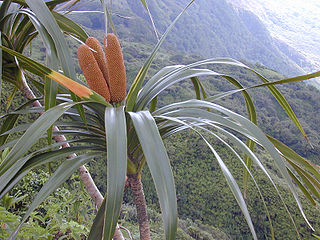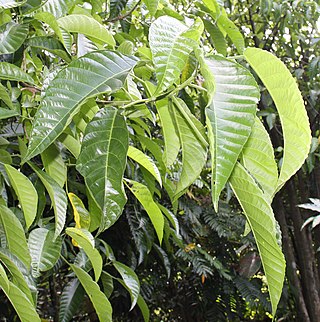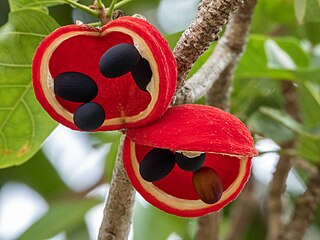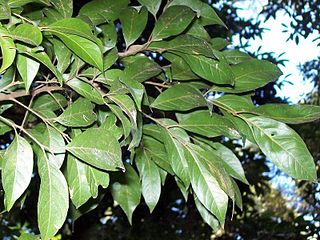
Alectryon is a genus of about 30 species of trees and shrubs from the family Sapindaceae. They grow naturally across Australasia, Papuasia, Melanesia, western Polynesia, east Malesia and Southeast Asia, including across mainland Australia, especially diverse in eastern Queensland and New South Wales, the Torres Strait Islands, New Guinea, the Solomon Islands, New Caledonia, New Zealand, Vanuatu, Fiji, Samoa, Hawaii, Indonesia and the Philippines. They grow in a wide variety of natural habitats, from rainforests, gallery forests and coastal forests to arid savannas and heaths.

Freycinetia is one of the five extant genera in the flowering plant family Pandanaceae. The genus comprises approximately 180–200 species, most of them climbers.

Cupaniopsis is a genus of about 67 species of trees and shrubs of the soapberry family, Sapindaceae. They grow naturally in New Guinea, New Caledonia, Australia, Torres Strait Islands, Fiji, Samoa, Sulawesi, Micronesia. Many species have been threatened with extinction globally or nationally, with official recognition by the International Union for Conservation of Nature (IUCN) and several national and state governments.
Pilidiostigma is a genus of shrubs and small trees in the myrtle family Myrtaceae. All species occur in Australia and one, P. papuanum, also occurs in Papua New Guinea. They are not generally known to horticulture. The species P. sessile is rare.

Diploglottis is a genus of 10 species of trees known to science, constituting part of the plant family Sapindaceae. They grow naturally in rainforests and margins of adjoining humid forests in eastern Australia and New Guinea. Some species are known as native tamarind or small-leaved tamarind; they have no direct relationship with the true tamarind.

Dendrocnide is a genus of approximately 40 species of plants in the nettle family Urticaceae. They have a wide distribution across North East India, Southeast Asia, Australia and the Pacific Islands. In Australia they are commonly known as stinging trees.

Sterculia quadrifida, also known as the peanut tree, or red-fruited kurrajong is a small tree that grows in the rainforests, vine thickets, and gallery forests of New Guinea and northern Australia.

Arytera is a genus of about twenty–eight species known to science, of trees and shrubs and constituting part of the plant family Sapindaceae. They grow naturally in New Guinea, Indonesia, New Caledonia, Australia, the Solomon Islands, Vanuatu, Fiji, Samoa, Tonga; and the most widespread species and type species A. littoralis grows throughout Malesia and across Southeast Asia, from NE. India, southern China, Borneo, Malaysia, Singapore, Indonesia and the Philippines to as far east as New Guinea and the Solomon Islands.

Atalaya is a genus of eighteen species of trees and shrubs of the plant family Sapindaceae. As of 2013 fourteen species grow naturally in Australia and in neighbouring New Guinea only one endemic species is known to science. Three species are known growing naturally in southern Africa, including two species endemic to South Africa and one species in South Africa, Eswatini and Mozambique.

Elattostachys is a genus of about 21 species of trees known to science, constituting part of the plant family Sapindaceae.

Buchanania is a genus of plants in the family Anacardiaceae and subfamily Anacardioideae.

Parinari is a genus of plant in the family Chrysobalanaceae.

Davidsonia pruriens, also known as ooray, Davidson's plum, or Queensland Davidson's plum, is a medium-sized rainforest tree of northern Queensland, Australia.

Jagera pseudorhus, commonly named foambark, is a species of rainforest trees, in the northern half of eastern Australia and in New Guinea, constituting part of the flowering plant family Sapindaceae. Named for the saponin foam that forms on the bark after heavy rain.
Ampelocissus acetosa is a species of vine. Common names include wild grape and djabaru.

Sarcopteryx is a genus of about 12 rainforest tree species known to science, of the plant family Sapindaceae. They occur in Australia, New Guinea and the Moluccas.

Terminalia microcarpa is a tree species in the family Combretaceae. It occurs throughout the Philippines, in parts of Malaysia and Indonesia, Papua New Guinea, possibly the Bismarck Archipelago, and northern Australia. It is cultivated on a small scale in the Philippines, where the edible sweet and tart plum-like fruits are eaten as is or are traditionally made into jams, jellies, and wines.

Sarcotoechia is a genus of tropical rainforest trees, constituting part of the plant family Sapindaceae.
Rhysotoechia is a genus of tropical rainforest trees, constituting part of the plant family Sapindaceae.
Nonda is a rural town in the locality of Maxwelton in the Shire of Richmond, Queensland, Australia.

















